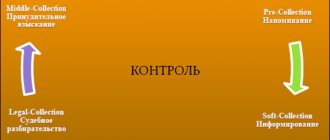Debt collection under a writ of execution is a long, complex and unpleasant procedure for both parties: the debtor and the creditor. Nevertheless, there are situations when such a step cannot be avoided. The procedure provides for two ways to repay debt in open proceedings: voluntary and forced.
If in the first case, with independent collection, the process can be completed quite quickly, then the involvement of bailiffs, as a rule, significantly extends the return of money over time. Read our material about how to initiate the debt collection procedure under a writ of execution, how to behave if you are a debtor, and how to better control the work of the BSC.
What you need to know about the debt collection procedure under a writ of execution
Let's start with what the concept of “writ of execution” (hereinafter IL) means. This is a type of document that is issued by a court decision or on the basis of other judicial acts and involves their forced execution. The sheet is sent to the bailiffs and both parties to the civil process on the day it begins to take effect, unless immediate execution of the verdict is provided (Article 428 of the Civil Procedure Code of the Russian Federation).
What information does this document contain:
- name and address of the court, full name of the official;
- name of the court case and its number;
- date of issue of the IL and day of entry into force;
- data of the lender (plaintiff) and borrower (defendant).
Until the court decision comes into force, the IL has no force and cannot justify the forced collection of the debt under the writ of execution.
As a rule, the reason for legal proceedings initiated by the bank is the borrower’s failure to fulfill the obligations stipulated by the loan agreement, namely:
- non-servicing of the loan for 90 days or longer;
- the borrower avoids communication with bank employees.
Guided by Federal Law No. 229 dated October 2, 2007 “On Enforcement Proceedings,” the creditor has the right to file a lawsuit to collect the debt. The purpose of these actions is to confirm the presence of debt on the loan and obtain the right to claim it from the defendant. A court decision in the case will be the basis for involving representatives of the FSSP (bailiffs) in the process of returning money, who are capable of forcibly collecting debts. In contrast, collectors and banks have limited powers and can only explain to the borrower that he is wrong.
In addition, not only credit institutions have the right to go to court. The client can always challenge the legality of the lender's claims by filing an objection to the claim.
Such documents are submitted within 14 days after the commencement of the court decision or the official approval of the writ of execution.
The objection to the statement of claim contains:
- the name and address of the court to which the application is filed;
- data from both sides of the civil dispute;
- details of the case and IL;
- arguments of the document submitter regarding the material or procedural side of the claim.
To confirm the legality of the objection, certificates, receipts and documents are required that prove:
- failure of the bank's claims;
- violation of procedural law when filing a claim;
- impossibility of collecting debt under a writ of execution for good reasons (client’s insolvency, illness, etc.).
The court will accept the borrower's application for consideration only if there is evidence, which professional lawyers will help collect.
Quite often, the parties to the conflict misunderstand the essence and purpose of IL. For the debtor, he establishes the amount of debt and the obligation to repay it. For a creditor, this is an effective tool that allows you to collect debt and force the client to fulfill contractual obligations. However, the writ of execution has a limited validity period and several nuances in the debt collection procedure. Therefore, let's look at its specifics in more detail.
First of all, the parties to the dispute must understand that IL is a measure of coercive influence. Therefore, the defendant should not rely on the loyalty of the FSSP; this is excluded due to the nature of the activities of these bodies.
Consequences of revocation of a writ of execution
The ability to cancel a writ of execution for a debt, although it is the right of any creditor, will not pass without consequences. Although most sources on the Internet say that canceling the document does not threaten you.
Clause 3.1 of Article 22 of the Federal Law on Legal Regulations says: if you have withdrawn a writ of execution, then the period of time between presenting it for execution and the end of execution on it will be deducted from the total period for presenting the writ of execution. It sounds complicated, but it's actually simple. According to paragraph 3 of Article 21 of the FZIP, you can present a writ of execution to the bailiffs within a three-year period from the moment you received it in court. This means that if the proceedings to collect your debt had been carried out by bailiffs for 2.5 years by the time you decided to cancel the document, then you will only have six months left to resubmit it. This calculation is correct if you submitted the writ of execution immediately upon receipt of it. But there is a great risk of not getting the debtor to pay the debt in full within six months. In this case, you will no longer be able to turn to bailiffs for help.
The procedure for collecting debt under a writ of execution
Those who received the IL for the first time must immediately check what is written there with the court decision and official documents on the case. The data must be identical everywhere: details of the plaintiff and debtor, all numbers and dates. If you find errors or omissions, demand that the defects be corrected.
The sheet is drawn up in the form and in accordance with the requirements approved by Government Decree No. 579 of July 31, 2008, which deals with IL forms.
After making sure that the document is properly executed and there are no errors or blots, you should choose a scheme for debt collection.
Method No. 1: letter from a credit institution.
1. If the debtor is an organization or individual entrepreneur
So, during the litigation, you found out where the borrower's active accounts are. Based on the aforementioned Federal Law-229 dated October 2, 2007, you can send a writ of execution to one of these institutions.
In this case, a statement is attached to the document in which you need to indicate the following data:
- details of the creditor's (plaintiff's) current account where the claimed debt will be transferred;
- for an individual - full name, citizenship, series and passport number of the claimant, place of registration or actual stay, Taxpayer Identification Number (if available), details of a migration card or other document that permits the plaintiff’s stay in the Russian Federation;
- for legal entities - the name of the organization, TIN or code of the foreign company, OGRN, place of state registration of the claimant and its legal address where the main activity is carried out.
An application for debt collection from an individual entrepreneur under a writ of execution or some organization is drawn up in 2 copies (for the bank and for you). The plaintiff’s sample must contain the signature of the person who accepted the documents, the date of filing and the seal of the legal entity.
If you do not know about the defendant’s current accounts and which bank serves him, you need to do the following:
- Prepare a notarized copy of the IL.
- With a copy of the writ of execution, go to the tax office and request the following information:
- names and addresses of banks and other credit institutions where the debtor opened current accounts;
- numbers of these accounts, the amount of money on the balance (in rubles, foreign currency) and movement on them.
After receiving the request within a week, the tax office should send a response with the information you need. To prevent the letter from being delayed during delivery, it is better to indicate in the request that you are expecting a response by express.
After receiving a response from the Federal Tax Service and making sure that the debtor has active accounts, you can, if desired, submit a writ of execution to all credit institutions, as we advised above.
2. If the debtor is an individual
The procedure for obtaining data from the Federal Tax Service on current accounts of ordinary debtors (individuals) is similar to the previous one (for enterprises and private entrepreneurs).
Debt collection under a writ of execution can be expedited by personally contacting the bank. You need to come to one of the branches where the defendant opened a current account and write a statement. The document should specify the amount of debt, indicate information about the applicant and the account for transferring money. When submitting an application, present the claimant's passport and the original IL. Here is a sample application:
Within two weeks, the amount of the debt must be transferred to the collector. If this does not happen, call the bank and find out why. Perhaps the money was seized by the bailiff service in the interests of another creditor, the account turned out to be empty, or the defendant did not use it for its intended purpose.
In this case, the claimant writes an application for the return of the IL and picks it up in person or receives it by mail. And having received the original document, he submits it to another financial institution.
As you can see, debt collection under a writ of execution can occur without the help of bailiffs. To do this, the creditor contacts the bank where the defendant has accounts, or his employer. It should be noted that the application to the Federal Tax Service is carried out at the place of registration of the borrower.
How debt is collected by bailiffs under a writ of execution
The professional activities of FSSP employees are regulated by law and regulations adopted within the department. However, their work constantly requires strict control over compliance with the rights of the applicant during enforcement proceedings (hereinafter referred to as IP). Practice has shown that thanks to the legal actions and determination of bailiffs, forced collection of debt occurs faster, and court orders are implemented much more efficiently.
The work of FSSP specialists begins after receiving documents on the presence of overdue loans from the applicant. The papers can be sent by the court that made the decision, or filed by the claimant himself.
Sometimes the sender is a notary (if there is an appropriate decision). These may be cases of non-repayment of a debt certified by a notary, or violation of an alimony agreement.
Upon receiving the applicant's papers, the bailiff prepares a resolution and opens enforcement proceedings against the debtor. He begins searching for his property and bank accounts.
The law allows six working days to initiate an IP, provided that the applicant applies to the SSP and does not bring documents to the person who will carry out the court decision. Three days are given to the department to hand over the sheet and all accompanying papers to the SPI (bailiff - executor). It will take the same amount of time to open the production itself.
In the IP process, the bailiff has the right to apply debt collection under a writ of execution to the property of the defendant, his financial resources in Russian bank accounts, to securities (if any), as well as to recurring payments (salary, pension, etc.)
A client who does not voluntarily pay off the fine after the start of the IP will be charged an enforcement fee - 7% of the amount, but a minimum of 1,000 rubles. (Article 112, part 3 of Federal Law-229 dated October 2, 2007). After a resolution on administrative sanctions comes into force, it is valid for two years and can be accepted for execution at any time (Article 31.9 of the Code of the Russian Federation on Administrative Offenses).
How bailiffs collect debt - general procedure:
- After receiving the IL for work, the bailiff opens enforcement proceedings within three days and sends the corresponding resolution to both parties to the dispute - the creditor and the debtor.
- If debt collection under a writ of execution is initiated for the first time, the SPI gives the debtor five days to voluntarily repay the loan. The period may vary and is determined at the discretion of the court.
- The next step in this process is to find the defendant's financial resources. The bailiff sends a request to his employer and collects information from various banks. The defendant's current accounts are subject to arrest for some time in order to prevent the movement of funds until the enforcement proceedings are completed.
- If there is money, the amount of the debt is withdrawn from the debtor's current account or deducted from incoming income. If no financial reserve is found, then the bailiff continues to search for the defendant’s property (movable and immovable).
- The borrower's discovered property is seized and assessed for further sale. If the proceeds from the sale exceed the defendant's debt, taking into account the enforcement fee, this difference is returned to him.
- If the debt is more than 10,000 rubles, then the SPI has the right to prohibit the borrower from traveling abroad.
- After collection of the debt under the writ of execution is completed, and repayment occurs later than the voluntary period, the bailiff must demand an enforcement fee from the defendant. This is 7% of the debt amount. In this case, the minimum withholding is: for ordinary citizens - 1,000 rubles, for organizations - 10,000 rubles.
- As soon as all due money (debt + fee) is fully collected from the defendant or his property, the bailiff closes the writ of execution.
Debt collection through the SPP is the final phase of the process of executing the court decision for which the IL was issued. However, a court ruling does not guarantee successful collection of an overdue loan.
Although the laws FZ-118 “On Bailiffs” and FZ-229 “On Enforcement Proceedings” regulate the activities of the FSSP, it may happen that after some time the bailiff who received your IL will give it back. The reasons for refusal may be: the absence of the defendant, who could not be found, and the fact that the value of his property does not cover the debt.
To avoid such an outcome, you need to delve into the work of the SPI and monitor its actions. All of the above rules are used to collect any debt, including alimony.
Deadline for debt collection under a writ of execution
After receiving the IL, the creditor submits it to the bailiff service and waits for quick repayment of the debt or fulfillment of other requirements stipulated by the contract. The terms of forced retention are established by Federal Law-229 and the Civil Code of the Russian Federation. FSSP employees must comply with them, as well as the debtor’s employer and the creditor.
After the court decision comes into force, the IL is valid for 3 years. According to the law “On Enforcement Proceedings,” two months are allotted for taking appropriate actions and collecting debt under a writ of execution.
These two terms must be distinguished! The time during which the IL can be submitted for execution and the period during which the bailiff must repay the debt to the creditor are not equivalent concepts.
Here are a few procedural nuances from Federal Law-229:
- the deadline for submitting a writ of execution to the SSP for forced collection of debt is calculated from the date of entry into force of the court decision and is 3 years;
- after the claimant submits the application, the bailiffs must open an individual entrepreneur within three days;
- FSSP employees are given two months for enforcement actions, during which time they need to seize current accounts (property) and begin retaining the debt (sale).
This is a theory, but in reality everything looks more complicated. As a rule, the execution period extends beyond the established period and lasts more than two months. But the bailiff must ensure repayment of the debt in accordance with the IL, if collection in one amount is impossible. To do this, the necessary documents are sent to the debtor’s employer in order to organize systematic deductions from his salary. Otherwise, his assets will be forcibly sold.
According to the general deadlines, debt is collected under a writ of execution from individuals and enterprises (LLC, KP, JSC, etc.). This includes overdue loans, insurer compensation, and housing and communal services debt.
For some cases, the law provides for a special period for claiming money, such as:
- disputes with budgetary institutions, since funds are transferred through the Treasury (the period for settlements with the creditor is 3 months);
- resolutions on administrative offenses, including traffic police fines (violators are given 60 days for voluntary payment, the validity period of the IL is 2 years);
- cases of bankruptcy of enterprises (the speed of obtaining funds depends on the efficiency of the manager and the amount of the stated claims of creditors).
In his decision, the bailiff must indicate the deadline for voluntary payment of the debt. Usually debtors are given no more than 5 days. During this time, the SSP can only seize the defendant's current accounts and property. After the 5-day period, interim measures and forced collection of debt under a writ of execution from the bank accounts of the defaulter may be applied.
Quite often during the trial the need for IL disappears. There are several reasons for this:
- the parties to the dispute have reached a settlement agreement;
- the plaintiff postponed debt collection;
- it is impossible to find the defendant’s location and contact him by phone;
- the arrest of the debtor's monetary assets and income, as well as the confiscation of his property, is impossible due to their absence;
- The statute of limitations for filing a claim has expired.
The period allotted for the return of debt under IL by SSP employees depends on the information provided by the debtor. If the applicant has provided detailed information about the defendant (personal information, valuable property, place of work), then the seizure and sale of assets is much faster. Our lawyers will help you prepare documents for submission to the SSP.
Legislation on executive documents
According to Art. 137 of the Labor Code, deductions from wages may be made in cases regulated by the Labor Code or specific federal laws. The amount of such withholding should not be more than 20%, and in some situations (according to specific regulations) - no more than 50%.
There are also situations in which the amount of withholding will not exceed 70%, for example, the collection of alimony payments, compensation for harm or damage. With this option, deductions are made regardless of how the employee feels about it. The main thing is that an official document from government agencies must be drawn up.
If the employee himself expresses his will to withhold any amount or percentage from his wages, then in this case the norm of labor legislation does not apply. In other words, there is no restriction on how much an accountant has the right to withhold a specific amount of money from an employee's salary.
Important! An official withholding document received by an organization has more legal force than a statement from an employee. In this regard, deduction should initially be carried out according to an official document from government agencies, and then by decision of the individual himself.
In what cases do bailiffs have no right to collect a debt?
The law provides for several special cases, in the event of which the collection of debt under a writ of execution is prohibited, even if the money has not been returned. Let's talk about them in more detail.
- Debt to the tax office. If arrears (penalties, fines) accrued by the Federal Tax Service are considered hopeless, they must be written off according to Art. 59 of the Tax Code of the Russian Federation, and the collection of money from the debtor has been stopped.
The tax office can write off the debt of individuals in the following cases:
- The bailiff service returned the writ of execution to the plaintiff due to the absence of the defendant or his property that could cover the debts.
- Five years have passed since the debt arose, and this amount is not enough to carry out the bankruptcy procedure (RUB 500,000 or more).
- The court did not accept the petition to declare the debtor bankrupt and refused to initiate a case, since the applicant is not able to pay for all the procedures.
- The defendant was declared insolvent in the bankruptcy case.
- Administrative penalty . All administrative sanctions must be fulfilled within 2 years from the beginning of the decision on their imposition. After this period, debt collection under a writ of execution or other punishments are prohibited in accordance with the provisions of the Code of the Russian Federation on Administrative Offences. And anyone who deliberately delays time and evades paying the fine will not be among the “lucky ones”, even if 2 years pass. The deadline will be temporarily delayed until the obstacles in debt collection are finally eliminated.
- "Not all at once" . In cases where the defendant has nothing but wages (pensions), the bailiff applies regular deductions from these incomes. The law does not allow deducting more than 50% of available income. The exception is overdue alimony and compensation for harm to health (life), where permissible deductions reach 70%. That is, for citizens from whom the maximum share of the mentioned income is already withheld, collection of other debts is impossible. The exception is a mortgage, where it is possible to sell the apartment to pay off the arrears.
Start of hold
At the initial stage, when processing a writ of execution, a specialist may encounter specific difficulties - at what point should deductions be made and how to determine the amount of debt under the document. The moment the retention begins is the date the company receives this document.
For example, if it was received by the employer in early October before the payment of the September salary, then the deduction must already be made from the salary for September. If the document is received by the company after the payment of the September salary, then the first deduction will be made from the salary for October.
When withholding, you also need to pay attention to whether it indicates a specific start date for the document. In many cases, bailiffs, as a rule, independently indicate the amount of debt. In a situation where an executive document is received by an organization much later than the specified start date of withholding, the accountant does not need to recalculate anything - he uses the figure indicated in the document from the date when the document came into his hands.
If the company is not sent a writ of execution, but, for example, a notarized agreement or a court order, then the accountant must act differently. With this option, he will have to independently determine the amount of debt, since a specific figure is not indicated in the document. For example, it may be formalized that alimony payments in the amount of 25% should be withheld from income. And then the accountant independently determines the amount depending on the employee’s income. In this case, the moment the retention begins will be the date specifically indicated in the document.









